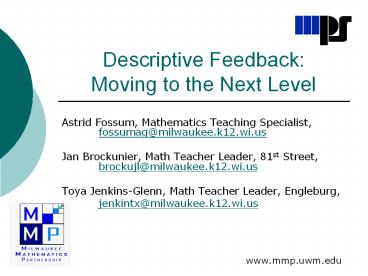Descriptive Feedback: Moving to the Next Level - PowerPoint PPT Presentation
1 / 16
Title:
Descriptive Feedback: Moving to the Next Level
Description:
Deepen their understanding of different types of feedback. ... Discuss ways to use feedback in the classroom to guide student learning in mathematics. ... – PowerPoint PPT presentation
Number of Views:22
Avg rating:3.0/5.0
Title: Descriptive Feedback: Moving to the Next Level
1
Descriptive Feedback Moving to the Next Level
- Astrid Fossum, Mathematics Teaching Specialist,
fossumag_at_milwaukee.k12.wi.us - Jan Brockunier, Math Teacher Leader, 81st
Street, brockujl_at_milwaukee.k12.wi.us - Toya Jenkins-Glenn, Math Teacher Leader,
Engleburg, - jenkintx_at_milwaukee.k12.wi.us
- www.mmp.uwm.edu
2
In this session
- Participants will
- Deepen their understanding of different types of
feedback. - Analyze student work in mathematics while writing
effective feedback statements. - Discuss ways to use feedback in the classroom to
guide student learning in mathematics.
3
Research
- Achievement gains are maximized in context where
educators increase the accuracy of classroom
assessments, provide students with frequent
informative feedback, and involve students deeply
in the classroom assessment, record keeping, and
communication process. In short, these gains are
maximized where teachers apply the principles of
assessment for learning. - Stiggins, 2005
4
Research
- Once students realize that information from both
teacher feedback and their own self-assessment
can help them improve, they will process material
more deeply, persist longer, and try harder. In
short, they will become more self-regulated
learners. - Brookhart, 2006
5
Descriptive FeedbackOur Journey
- To use student work from CABS to drive
instructional decisions on what we do next in
the classroom and to provide appropriate and
continuous feedback to students. - How do teachers give students descriptive
feedback that prompts them to self-reflect on
ways to improve their work?
6
Types of Feedback
- Motivational Feedback
- Evaluative Feedback
- Descriptive Feedback
- Effective Descriptive Feedback
7
Motivational Feedback
- Goal is to make the learner feel good.
- Feedback that is intended to encourage and
support the learner. - Does not give guidance on how to improve the
learners reasoning. - I like how you completed the assignment.
8
Evaluative Feedback
- Goal is to measure student achievement with a
score or a grade. - Feedback that is intended to summarize student
achievement. - Does not give guidance on how to improve the
learners reasoning. - 73
9
Descriptive Feedback
- Goal is to improve student achievement by telling
the learner what steps to take in order to move
forward in the learning process. - Feedback that is intended to tell the learner
what needs to be improved. - Gives specific guidance as to how to improve the
learners reasoning. - You accurately found the number of students in
4th grade who said ice cream was their favorite.
You now need to divide this number by the total
number of students to get the percent who said
ice cream was their favorite.
10
Effective Descriptive Feedback
- Goal is for students to internalize the effective
feedback. - Feedback that is intended to be used by the
learner to independently move their reasoning to
the next level. - I agree with the pattern that you have
identified in the table. I am not convinced that
the rule you wrote works for all the values in
the table. How could you prove this?
11
Types of Feedback
Motivational Evaluative Descriptive Effective
Feedback is primarily motivational Feedback is primarily evaluative Descriptive feedback primarily tells the student how to correct their reasoning. Descriptive feedback asks the student what to do to move their reasoning to the next level.
Purpose to encourage and support the learner Purpose to measure student achievement with a score or a grade Purpose to improve learning by indicating to the student what needs to be improved Purpose to improve learning, by moving student reasoning to the next level
More Summative More Formative
12
6th grade CABS
- Wendell is planning to carpet the room below. He
does not plan to carpet the closet. What is the
area of his room in square yards? - 1 square yard 9 square feet
- Answer _______
- Explain how you determined the area of the room
13
Engleburg School
- Students
- Evidence of understanding
- Effectiveness
- The unexpected
- Future Goals
- Teachers
- Record keeping
- Buy in
- The unexpected
- Future Goals
14
81st Street StoryOur Journey
- The path of the student
- The path of the teacher
- Time
- Collaboration
- Paradigm shift
- The road not knownOur next steps
15
Questions
- Implementation
- Students responses
- Teachers responses
- Administration
- Future Plans
- Support
16
In closing
- The most powerful single modification that
enhances achievement is feedback. The simplest
prescription for improving education must be
dollops of feedback. Hattie, 1992































